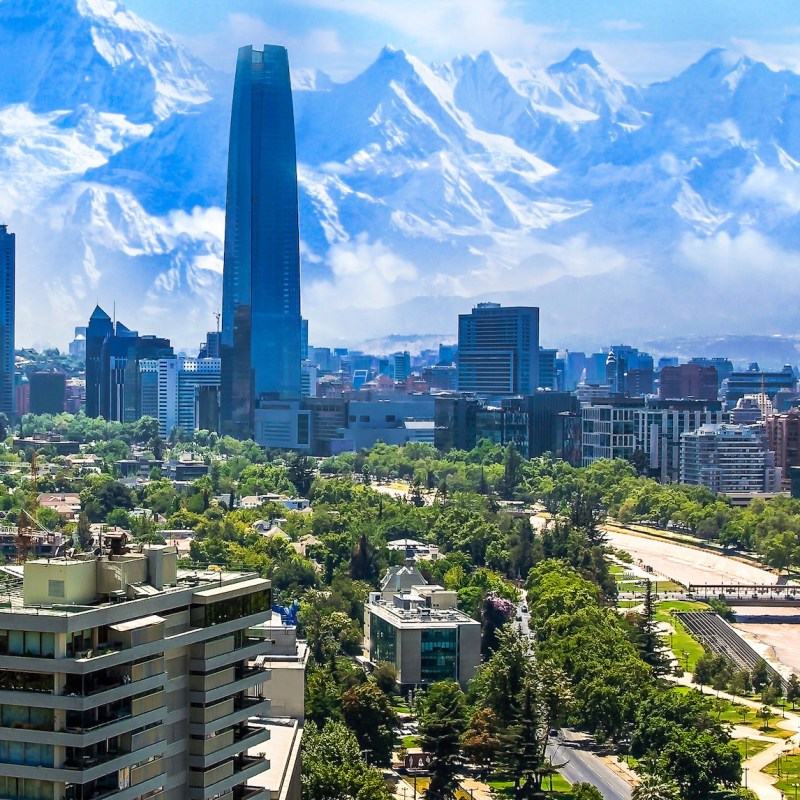
Traditional. Dynamic. Cosmopolitan. Cultured. Meet Chile’s thriving capital city — a colonial jewel on the cusp of a cosmopolitan debut.
Videos by TravelAwaits
Traditionally Santiago is a stopping point for intrepid travelers heading south to the edge of the world in Patagonia. And while Santiago may have ranked in the past as a one- or two-day stopover, this thriving cultural capital is absolutely worth a trip of its own. Come discover a centuries-old city, wreathed in the Andean mountains, equidistant from the beach and the ski slopes, packed with art, culture, cuisine, and dance. Santiago is a jewel of a city and it’s been vying for its turn in the spotlight for quite some time. Here are eight reasons to add Santiago, Chile to your travel bucket list.

1. It Is A Cross Section of Old and New World
Santiago, Chile, was officially “founded” in the 16th century by Spanish conquistador Pedro de Valdivia. But in actuality, the city was inhabited long before that by the indigenous Picunche people. Today it is a melange of cultures, as well as home to 40 percent of the Chilean population. It is a thriving capital city surrounded by imposing (and breathtaking) snow-capped peaks. It is home to architectural remnants of the colonial era, which sit alongside 20th-century masterpieces. Life here moves at a cosmopolitan clip but there is no lack of respect for its mestizo artisanship, especially when it comes to traditional music, theater, literature, and art.
Begin your immersion into Chilean cultures at Museo Chileno de Arte Precolombino. Learn about the indigenous past through pottery, stone columns, totems, and textiles. Meanwhile, the Chilean National Museum of Fine Arts, a national landmark, will bring you up to 20th-century speed with its collection of masterpieces. The building was constructed in the 19th century and contained just 140 paintings by Chilean artists to start. Today it has more than 5,000 pieces in its collection that span history and artists from not only Chile but all over the world.

2. Its Gastronomy Is Worth Traveling For
When was the last time someone suggested Chilean food for dinner? Granted, knowledge about Chilean dishes isn’t as widespread as cuisine from some other South American countries (Peruvian or Brazilian, anyone?), but the food in Chile is absolutely worth traveling for, especially when it comes to dining in the capital.
Chilean cuisine centers around seafood since Santiago is just an hour and a half from the Pacific. Peruvian ceviches are incredibly popular in Santiago, but another surprising staple is sushi, which is becoming an increasingly popular and perfected style of cuisine in Santiago.
Another popular Chilean dish is pastel de choclo, which is a meat-and-veggie pie topped with cornmeal. Wash it down with a terremoto, or earthquake, a mixed drink conceived in Santiago that’s made of sweet wine, Pisco liquor, pineapple ice cream, and a splash of grenadine.
The real flavor of Chilean cuisine can be found in its many markets. First is Mercado Central, which is considered a historical landmark. Seafood in Santiago is exquisite, and some of the best can be found at the market restaurants. Tip: Eat at the restaurants along the sides of the market to snag local prices, rather than those in the center, which attract more tourists.
Chile’s biggest market is La Vega Central, the local fruit and vegetable market, which is right across the street from Mercado Central.
3. Chilean Wine Is Always A Good Idea
Of course, if you’re in Chile and like wine, you will likely seek out opportunities to sample some — or a lot — of it! Many of Chile’s vineyards are close to Santiago, and several are accessible by the Metro, including the world-renowned Concha y Toro. Casablanca Valley between Santiago and Valparaiso is a wonderful spot to make a day of wine tasting.

4. Its Neighborhoods Are Energetic And Eclectic
Santiago is divided into very distinct barrios (neighborhoods), each of which has its own personality and flair. No doubt the one most travelers are familiar with is Bellavista, the city’s most “bohemian” neighborhood. Here visitors will find street art, restaurants, cocktail bars, and some of the best views over the entire city. This also happens to be the neighborhood poet Pablo Neruda called home. Be sure to visit his home-turned-museum, La Chascona.
Lastarria is another artsy neighborhood that many visitors are charmed by. It is close to the Museo Bellas Artes and has an emerging food scene as well as galleries, antique shops, and lovely green space.
Tap into the history of Santiago with a visit to the Centro Historico. Here you’ll find the main historic sites of the city, from the Plaza de Armas and the Cathedral of Santiago to the National Historical Museum.
Tap into the international side of Santiago with a visit to Patronato, the cosmopolitan heart of the city, known for its international residents, cuisine, shopping, and chic lifestyle.
5. Its Music And Dance Will Ignite Your Soul
The rhythm of Chile pulses from its heart in Santiago. Here salsa reigns supreme, from live shows to dance clubs. Havana Salsa has live shows every Thursday, Friday, and Saturday, and if you’re interested in picking up a few steps of your own, they also offer classes on Monday, Tuesday, and Wednesday.
Santiago also has a thriving jazz scene. Club de Jazz is the premier hangout for jazz aficionados, as its stage has drawn the likes of Louis Armstrong and Wynton Marsalis.

6. It Is The Gateway To Patagonia
While many visitors breeze through Santiago on a connecting flight down to Patagonia, Santiago’s location amid the mountains is a wonderful and accessible way to absorb the humbling majesty of Chile’s natural environment.
Any Santiago journey should involve some time to drink in the sweet, sweet views. For most, this will involve a stop at San Cristobal Hill in the middle of the city. More adventurous travelers can make the 45-minute hike (or cycle) to the summit, or opt for the more relaxing option: a funicular which stops at different points along the hill. At the top is one of the most iconic sites in Santiago — a 984-foot-high statue of the Virgin Mary gazing out over sweeping views of the surrounding mountains that tower over the city.
Tip: Another great viewpoint is Cerro Santa Lucia, which also has 360-degree panoramic views. The hill is about a 20-minute walk, and there is no funicular, but those who make the ascent will discover statues, murals, and ponds along the way.
Santiago is also an incredibly green city, known for its beautiful park space. Parque Forestal is undoubtedly one of the best, with open stretches of green along the Mapocho River. Within this city oasis are notable sites like the Monument to Writers of Independence and the National Museum of Fine Arts.
Did you know Chile is the ski capital of South America? Skiers can hit the slopes at Valle Nevado, El Colorado, or La Parva, all of which are about an hour from the city. If it’s more of a dedicated ski holiday you’re after, Portillo, about a two-hour drive from Santiago, is one of the best ski resort destinations on the continent.

7. Its Streets Were Made For Walking (Or Biking)
Santiago is absolutely made to be seen on foot (or by bicycle). Nothing puts a traveler at the root of a destination like seeing it from a local’s perspective, and since the city itself is mostly flat and its Metro system is easily navigated, options for “going local” are plentiful. Metro trips start at under $1 and there are many different urban walking tours available. Alternatively, you can download tours to your phone and make a DIY day of it.
Biking is another fantastic option for exploring the city. Most bike shops rent by the day, but several shops will offer long-term rentals, too. The city has a large number of bike paths and has started a local bike sharing program. Companies like La Bicicleta Verde also rent out bikes and offer self-guided tours.

8. The Architecture Is Awe Inspiring
You won’t be starved for national monuments or landmarks in Chile’s capital. With a history that spans nearly 500 years, there is a long list of impressive buildings with intricate architecture that will captivate even the most discerning traveler.
Start with the Plaza de Armas, one of the main historical centers of the city. The square is fringed in palm trees and lined with some of the premiere architectural gems of the city, from the Metropolitan Cathedral to the Central Post Office and the Royal Court Palace.
But Santiago has more than just traditional architecture. Be prepared for something a bit more curious at the Baha’i Temple, a place of worship that looks like a closed-up flower bud with translucent petals. It is one of the more obscure buildings in the city, situated on a lofty perch overlooking the valley below.
And speaking of atypical, Sky Costanera is absolutely worth a stop for its 64th-story view of Santiago. The Gran Torre Santiago, as it’s called, is open year-round and is the highest lookout in South America.
Back to the classics, the Edificio del Ex Congreso Nacional, or the National Congress of Chile, is a prime example of neoclassical architecture with beautiful Corinthian columns. The building was built between 1857 and 1895. Today it houses the Chamber of Deputies and the Senate as well as the Library of Congress, and is surrounded by gardens perfectly suited for leisurely strolls.

